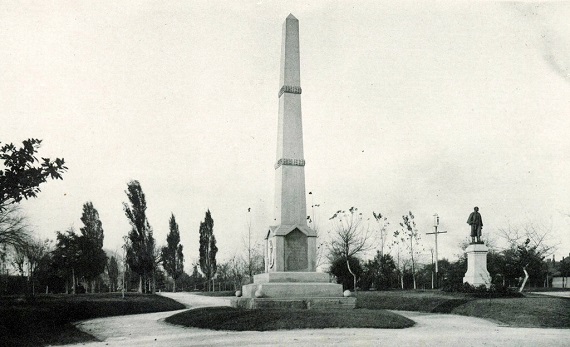
When Jefferson County Circuit Judge Michael Graffeo issued a ruling on the Alabama Memorial Preservation Act just minutes before his term expired last week, he upended the entire understanding and meaning of the original Constitution and the relationship between the States, the cities, and the general government. More importantly, though Graffeo’s decision will probably–not definitely–be overturned, the ruling provides a cautionary tale in ongoing efforts to pass similar legislation across the South.
But first, a brief history of the controversy is in order. The City of Birmingham began discussing plans to remove the Linn Park Soldiers and Sailors Confederate Monument in 2015 after the Emanuel A.M.E. Church massacre in Charleston, SC. Just one week later, then Governor Robert Bentley ordered that all Confederate flags be removed from the Alabama Confederate Monument on Capitol Hill in Montgomery. In response, the Alabama legislature began crafting the Memorial Preservation Act aimed at protecting all monuments and memorials across the State, not just those dedicated to Confederate history. Bentley was eventually forced to resign for corruption and the Act was signed into law in April 2017 by Governor Kay Ivey.
Four months later, the City of Birmingham, at the direction of former Mayor William Bell, covered the Linn Park Confederate Monument in plastic and erected a tall, black plywood barrier around its base after Ohio resident James Alex Field murdered Heather Heyer following the 2017 “United the Right” rally in Charlottesville, VA. Bell stated he did so because, “This country should in no way tolerate the hatred that the KKK, neo-Nazis, fascists and other hate groups spew.” How that related to an inanimate object dedicated over one hundred years earlier by the United Daughters of the Confederacy (not the KKK) and nearly thirty years before the rise of fascism was unclear. This was political grandstanding at its finest.
The State then sued the City of Birmingham for violating the Preservation Act, and as per the law, began demanding a $25,000 daily fee as long as the barriers remained around the Linn Park monument. The City refused to pay, hired the Southern Poverty Law Center to help defend it in court, and kept the “plywood screen” in place for over a year.
This seemed to be a certain victory for the State. The cornerstone for the Linn Park monument was dedicated in 1894 and the monument was finally completed in 1905, making it more than forty years old. The “barrier” clearly “altered” and “disturbed” the monument because it prevented people from seeing most of the memorial or reading the inscriptions on the base. The State also contended that the City lacked standing in the case because as cities are “creatures or instrumentalities of their state of origin” they are not private citizens and therefore have no individual rights.
The City argued that the law violated its right to freedom of speech and right to due process as outlined by the First and Fourteenth Amendments to the Constitution and because corporations (cities) are persons, the State was denying fundamental civil liberties.
Graffeo, in a thinly veiled political ruling, sided with the City. He reasoned that, “It is undisputed that an overwhelming majority of the of the body politic of the CITY is repulsed by the Monument.” Graffeo argued that the city has a “right to speak for itself, say what it wishes, and select the views that it wants to express,” and that by forcing the City to accept a monument with a message it finds “repulsive,” the state of Alabama was infringing on that right. He also contended that the State violated the Fourteenth Amendment by prohibiting the City from moving or altering an object on city property, thus preventing proper due process.
His entire ruling is a distortion of federalism, due process, the Bill of Rights, and the Fourteenth Amendment.
Both the Tenth and Eleventh Amendments to the Constitution make clear that the States are the building blocks of the general government. States retain all powers not delegated to the central authority and cannot be sued without their consent. The general government, then, is the creation of the States or the people thereof, as are cities and municipalities. While Graffeo did not deny that States have extensive powers over cities, he believes that those powers are limited by the Constitution because cities are somehow “persons.”
The notion of “corporate personhood” is a relatively recent creation of the federal court system. No one in the founding generation considered corporations to be “persons,” and more importantly, the ability to charter corporations is not a delegated power of the general government, Alexander Hamilton’s opinion notwithstanding. Only sovereign entities (States) can charter corporations, and as such the State of Alabama could revoke the charter for the City of Birmingham and confiscate all city property. In other words, the City does not technically “own” the property under the Linn Park monument; the State does.
Moreover, a city having “free speech rights” would have been an anathema to the founding generation. Individuals could certainly protest the Linn Park Monument. They could stand in front of it all day with bullhorns and signs as long as they did not prohibit others from expressing their own view of the obelisk, disturb the peace, or incite violence. That is protected by Section 4 of the Alabama Constitution, the Constitution Graffeo should have referred to in his decision. But a city is not a person and therefore does not have “free speech rights,” unless, that is, you agree with the 2010 Supreme Court decision in Citizen United v. Federal Election Commission, which did more than any other decision to craft the “corporate personhood” argument in modern American jurisprudence. Graffeo sounds a lot like John Roberts.
The legal relationship between the general government and the States also illustrates that the States are sovereign, and thus, as the Attorney General of Alabama noted, the City of Birmingham had no standing in the case. Graffeo disagreed, but the historical evidence does not support his opinion. The United States general government cannot legally revoke the status of a State. In fact, when Hamilton proposed that the States be reduced to mere corporations of the general government at the Philadelphia Convention in June 1787, he was entirely ignored and his plan rejected. The “friends of the Constitution” insisted that the States retained all “police powers” and that the general government possessed only the powers expressly–the word was used in public defense of the document–delegated to it by the states. In other words, the States weren’t giving up their control of the federal system, nor were they surrendering their sovereignty. The Constitution would not have been ratified under any other meaning. The Congressional Radical Republicans during Reconstruction certainly insisted they had the power to do so, and
Additionally, Graffeo’s contention that the Memorial Preservation Act denies the City due process is a distortion of the term. The founding generation, and even the authors of the Fourteenth
Considering the City as a person with “free speech rights” also twists the meaning and intent of the Bill of Rights and the Fourteenth Amendment. Incorporation of the Bill of Rights against the States is the greatest legal coup of the twentieth century, and it was made possible by, ironically enough, a former Klan member from Alabama, progressive Supreme Court Justice Hugo Black. Through a series of rulings in the 1950s and 1960s, the Supreme Court decided, against the historical record of both the Bill of Rights and the Fourteenth Amendment, that the civil liberties protected by the First Amendment also applied to the States. Black wanted to do so, in part, to prevent Catholic schools from using taxpayer funded buses to transport children to school. His incorporationist dream has eventually been applied to every other Amendment in the Bill of Rights, but that does not make it legal or proper.
Ultimately, Graffeo’s ruling is interesting because if anyone follows his logic, and the appellate courts sustain his decision, a city or municipality could prohibit pornography or saggy pants, for example, under the cover that these things are “repulsive” and that the local government could “select the views that it wants to express,” or deny those views it seeks to censure for the welfare of the “overwhelming majority of the body politic.” That would be democracy in action, but it would certainly be opposed by the same progressives who are now championing this outrageous decision. Regardless, those crafting current monument protection legislation in various States should consider Graffeo’s decision as a warning that progressive justices and their legal allies will use any method–including hypocrisy, historical amnesia, and blatant distortion of the law–to advance their agenda.






